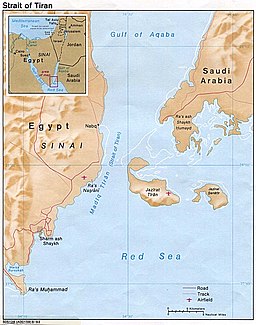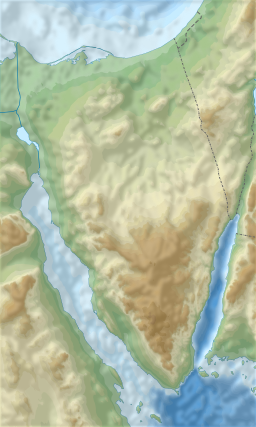Straits of Tiran
| Straits of Tiran | |
|---|---|
 | |
| Coordinates | 28°00′14″N 34°27′55″E / 28.00389°N 34.46528°E |
| Max. width | 13 km (7 nmi) |
| Average depth | 290 m (950 ft) |
| Islands | Tiran Island |
The Straits of Tiran (Arabic: مضيق تيران Maḍīq Tīrān) are the narrow sea passages between the Sinai and Arabian peninsulas that connect the Gulf of Aqaba and the Red Sea. The distance between the two peninsulas is about 13 km (7 nautical miles). The Multinational Force and Observers monitors the compliance of Egypt in maintaining freedom of navigation of the straits, as provided under the Egypt–Israel peace treaty.[1][2][3]
The body is named after Tiran Island, located at its entrance 5 or 6 km (3 or 4 mi) from the Sinai. Sanafir Island lies to the east of Tiran, southeast of the shallow strait between Tiran and Saudi Arabia.
The blockade of Israeli passage through the Suez Canal and Straits of Tiran led to two wars, in 1956 and 1967.
Background

International documents inconsistently refer to both the "Straits of Tiran" and the "Strait of Tiran". There are several passages formed by the islands between Egypt and Saudi Arabia. The westernmost strait, between Egypt and the island of Tiran, overlooked by the Egyptian city Sharm El Sheikh, is the "Strait of Tiran", 5 or 6 km (3 or 4 mi) wide. It has two passages deep enough to be navigable by large ships. The Enterprise passage, 290 metres (950 ft) deep, is adjacent to the Egyptian side, while the 73-metre (240 ft)-deep Grafton passage, surrounded by shallows, is to the east, nearer to the island of Tiran. To the east of Tiran, between it and Saudi Arabia, the other strait has reefs and shallows with a single channel 16 metres (52 ft) deep.[4]
Closures in 1948–1956 and 1967
This section needs expansion with: any information at all about the closure in 1948–1956. You can help by adding to it. (December 2023) |

Access to Jordan's only seaport of Aqaba and to Israel's only Red Sea seaport of Eilat is through the Gulf of Aqaba, which gives the Straits of Tiran strategic importance.[5][6] In 1967, 90% of Israeli oil passed through the Straits of Tiran, making it a target of Egyptian blockade during the Arab League boycott of Israel.[7]
In May 1967, Israeli Prime Minister Levi Eshkol repeated declarations that Israel had made in 1957, saying that closure of the Straits of Tiran would be an act of war.[8][9] Egypt then blockaded the straits on May 22, 1967, and oil tankers that were due to pass through the straits were required to submit documents ensuring their cargo was not destined for an Israeli port.[10][11] At that time, Israel viewed the Straits of Tiran as a vital interest as it is where Israel received vital imports, mainly oil from Iran, and a blockade threatened Israel's ability to develop the Negev.[12]
In May 1967, Major General Indar Jit Rikhye was the commander of the United Nations Emergency Force (UNEF) in the Sinai peninsula when Egypt deployed its own troops in that territory and demanded that Rikhye withdraw all of his troops. Rikhye did withdraw, including from the port at Sharm El Sheikh adjacent to the straits. The subsequent closure of the Tiran Straits by Egypt was closely linked to the preceding UNEF withdrawal, because having the peacekeepers (rather than the Egyptian military) at Sharm El Sheikh was important for keeping that waterway open.[13] Later in life, General Rikhye sought to downplay the importance that Israel attached to keeping that waterway open, saying that Israel's accusation in 1967 of a blockade was "questionable" given that an Israeli-flagged ship had not passed through the straits in two years, and that "The U.A.R. [Egyptian] navy had searched a couple of ships after the establishment of the blockade and thereafter relaxed its implementation".[14] Egypt had initially requested UNEF withdrawal from locations other than Sharm El Sheikh,[15] but UN Secretary-General U Thant demanded an all-or-nothing withdrawal.[16]
The US president at the time, Lyndon Johnson, said the following about closure of these straits being a cause of the Six-Day War:[17][18]
If a single act of folly was more responsible for this explosion than any other, it was the arbitrary and dangerous announced decision that the Straits of Tiran would be closed. The right of innocent, maritime passage must be preserved for all nations.
Bridge project
The Saudi–Egypt Causeway, a proposed project to build a 15-kilometre (9.3 mi) bridge across the straits, linking Egypt and Saudi Arabia, is under consideration by the Egyptian government.[19]
See also
- Sanafir Island
- Suez Crisis
- Six-Day War
- Yom Kippur War
- Closure of the Suez Canal (1967–1975)
- The Line, Saudi Arabia
- Saudi–Egypt Causeway - proposed bridge over the Straits of Tiran from Saudi Arabia to Egypt
- Tiran Island
- Israeli passage through the Suez Canal and Straits of Tiran
References
- ^ Aronson, Geoffrey (August 27, 2015). "The Multinational Force of Observers and the Sinai Storm". Middle East Institute. Retrieved 2021-09-08.
- ^ "The Future of the Multinational Force and Observers in Sinai". The Washington Institute. Jan 25, 2002. Retrieved 2021-09-08.
- ^ "MFO - Origins". Multinational Force and Observers. Retrieved 2021-09-08.
- ^ Carl F. Salans (December 1968). "Gulf of Aqaba and Strait of Tiran: Troubled Waters". Proceedings. 94 (56). United States Naval Institute.
- ^ Robert Priewasser, Tiran Island and Straits of Tiran. Unexplained Sovereignty over an Island in the Context of the Arab-Israeli Conflict (Saarbrücken: Akademikerverlag, 2013)
- ^ Oren, Michael B. (2002). Six Days of War: June 1967 and the Making of the Modern Middle East. Oxford: Oxford University Press. ISBN 0-19-515174-7.
- ^ Shlaim, Avi; Louis, William Roger (13 February 2012). The 1967 Arab-Israeli War: Origins and Consequences. Cambridge University Press. p. 224. ISBN 978-1-107-00236-4.
90% of Israeli oil was imported through the Straits of Tiran
- ^ Neff, David. Warriors for Jerusalem: The Six Days that Changed the Middle East, p. 88 (Simon & Schuster, 1984): "In separate messages to the leading maritime powers, Eshkol warned: 'Israel would stop short of nothing to cancel the blockade. It is essential that President Nasser should not have any illusions.'"
- ^ "Statement to the General Assembly by Foreign Minister Meir, 1 March 1957" (Israel Ministry of Foreign Affairs): "Interference, by armed force, with ships of Israeli flag exercising free and innocent passage in the Gulf of Aqaba and through the Straits of Tiran will be regarded by Israel as an attack entitling it to exercise its inherent right of self-defence under Article 51 of the Charter and to take all such measures as are necessary to ensure the free and innocent passage of its ships in the Gulf and in the Straits."
- ^ Shlaim & Louis (2012), p. 27
- ^ "Daily brief to the U.S president on 27 May 1967" (PDF). 27 May 1967.
diverted as was a sister ship yesterday
- ^ Bregman, Ahron (2013). Israel's Wars: A History since 1947. Taylor & Franci. p. 7. ISBN 978-1-135-68787-8.
- ^ Avi Shlaim; William Roger Louis (13 February 2012). The 1967 Arab-Israeli War: Origins and Consequences. Cambridge University Press. p. 63. ISBN 978-1-107-00236-4.
the occupation [by Egypt] of Sharm-al-Sheikh would force the closure of the Tiran Straits
- ^ Rikhye, Indar Jit (1980). The Sinai Blunder: Withdrawal of the United Nations Emergency Force Leading to the Six-Day War of June 1967. London: Rutledge. ISBN 0-7146-3136-1.
- ^ Quigley, John (December 2012). The Six-Day War and Israeli Self-Defense, Kindle Location 485. Cambridge University Press. Kindle Edition.
- ^ Segev, 2007, op. cit., p. 274.
- ^ Ben Gad, Yitschak. Politics, Lies, and Videotape: 3,000 Questions and Answers on the Mideast Crisis, p. 182 (SP Books, 1991).
- ^ "LBJ Pledges U.S. to Peace Effort", Eugene Register-Guard (Jun 19, 1967). See also Johnson, Lyndon. "Address at the State Department's Foreign Policy Conference for Educators" (June 19, 1967).
- ^ Najla Moussa (2 March 2006). "Bridge connecting Egypt, Saudi Arabia considered". Daily News Egypt. Retrieved 11 April 2016.



